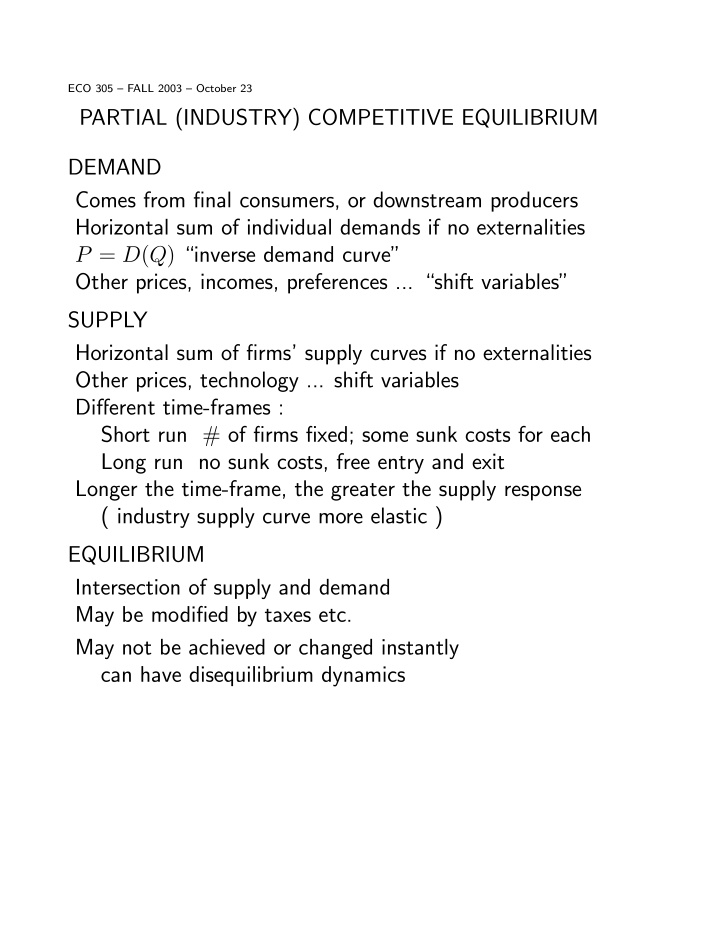



ECO 305 — FALL 2003 — October 23 PARTIAL (INDUSTRY) COMPETITIVE EQUILIBRIUM DEMAND Comes from fi nal consumers, or downstream producers Horizontal sum of individual demands if no externalities P = D ( Q ) “inverse demand curve” Other prices, incomes, preferences ... “shift variables” SUPPLY Horizontal sum of fi rms’ supply curves if no externalities Other prices, technology ... shift variables Di ff erent time-frames : Short run # of fi rms fi xed; some sunk costs for each Long run no sunk costs, free entry and exit Longer the time-frame, the greater the supply response ( industry supply curve more elastic ) EQUILIBRIUM Intersection of supply and demand May be modi fi ed by taxes etc. May not be achieved or changed instantly can have disequilibrium dynamics
COMPARATIVE STATICS Change in some exogenous variable Shift of one curve, causes movement along the other Compare new equilibrium with old EXAMPLE — TAX INCIDENCE ECO 102 PICTURE P d = price paid by consumers P s = price received by fi rms t = tax per unit of the good With “normal” D and S P d rises by less than t P s falls by less than t Q decreases
CALCULUS METHOD P d = D ( Q ) , P s = S ( Q ) , P d − P s = t Everything is a function of t . Di ff erentiate: dP d dt = D 0 ( Q ) dQ dP s dt = S 0 ( Q ) | dQ dt , dt , and dP d − dP s dt = 1 dt Substitute and solve (eqns. linear in derivatives) dQ 1 dt = D 0 ( Q ) − S 0 ( Q ) D 0 ( Q ) S 0 ( Q ) dP d D 0 ( Q ) − S 0 ( Q ) , dP s dt = dt = D 0 ( Q ) − S 0 ( Q ) In “normal” case D 0 ( Q ) < 0 , S 0 ( Q ) > 0 , and dQ 0 < dP d − 1 < dP s dt < 0 , dt < 1 , dt < 0 Enables more precise quantitative calculations CS and PS
CONSUMER SURPLUS PRODUCER SURPLUS Utility: U ( x, y ) = y + F ( x ) Cost: C ( x ) Budget: p x + y = M Pro fi t: Π ( x ) = p x − C ( x ) FONC: p = F 0 ( x ) FONC: p = C 0 ( x ) SOSC: F 00 ( x ) < 0 SOSC: C 00 ( x ) > 0 When quantity q consumed, When quantity q produced, Z q Z q 0 F 0 ( x ) dx 0 C 0 ( x ) dx F ( q ) = F (0) + C ( q ) = FC + Spending E = p q = q F 0 ( q ) Revenue R = p q PS(q) = R − [ C ( q ) − FC ] CS(q) = [ F ( q ) − F (0)] − E F ( q ) − C ( q ) = CS ( q ) + PS ( q ) + FC − F (0) Social optimum: F 0 ( q ∗ ) = C 0 ( q ∗ ) = p ∗ Achieved in competitive equilibrium
Recommend
More recommend